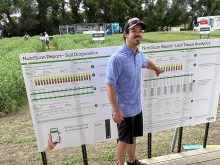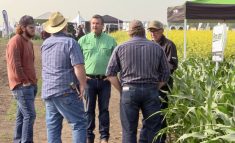After two years of staring and shaking their heads at soaked fields, producers in Manitoba’s Interlake are finally feeling more optimistic about soil conditions in the region, said Darvin Firman, who farms north of Arborg.
“To have all the snow basically gone, other than in the tree line, we’re in pretty good shape I’d say,” said Firman, who runs a cattle and grain operation with his brother Andy.
Record rainfall in the summer of 2008 followed by an extremely wet spring in 2009, completely saturated much of the Interlake.
Read Also

New fertilizer product aims to reduce tie-up, improve soil health
A new phosphorus fertilizer, launched at Ag in Motion 2025, promises to reduce nutrient tie-up and deliver slow-release feeding throughout the growing season.
The wet conditions were so severe that approximately 200,000 acres in the region went unseeded in 2009 and many farmers were unable to seed.
There were concerns that the unseeded land wouldn’t dry up in time for planting in 2010, said Andy Nadler, an agricultural meteorologist with the Manitoba government.
“As of right now, things are looking pretty good in the Interlake,” said Nadler.
Fortunately, the region had a much drier than usual fall and winter this year, based on Agriculture Canada precipitation data.
From Sept. 1, 2009 to the end of March, the area between Gimli and Fisher Branch received 50 to 75 millimetres of rain and snow. That represents 120 to 160 mm less than normal.
The lack of precipitation has been a benefit to the Interlake, but it is a bit of a concern in the Swan River region.
“The northwest has been a bit dry – the Swan River area, Russell and Roblin,” he said.
In fact, Environment Canada’s weather station in Swan River only recorded 11 mm of precipitation from Jan. 1 to the end of March. In a more typical year, Swan River receives 68 mm of snow and rain in January, February and March.
Manitoba Agriculture data indicated the soil in the Swan River region was dry going into the winter, Nadler said.
“From sampling in the fall, some of those sites were less than 50 percent (field capacity),” he noted. “If you figure the soil is like a gas tank, you’re less than half full.”
Across the province, it was a different spring melt than 2009, Nadler added. Last year, there was standing water on most fields in Manitoba.
“We’ve had an interesting melt. It’s pretty quick and pretty early,” Nadler noted.
“This year there doesn’t seem to be as much ponding. The snow is melting and kind of disappearing.… That’s usually a sign of drier soils just because you have that pore space.”
Nonetheless, soil moisture conditions are better in the rest of the province’s agricultural land, Nadler said, because the land isn’t completely soaked in the Red River Valley and soils in the usually dry southwest are in better shape.
“They had a good snowpack (in the southwest) so that certainly helps.”















